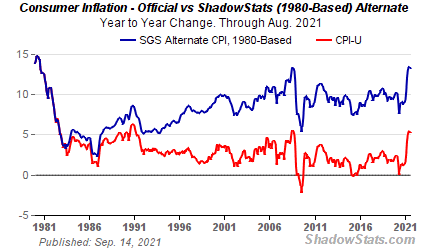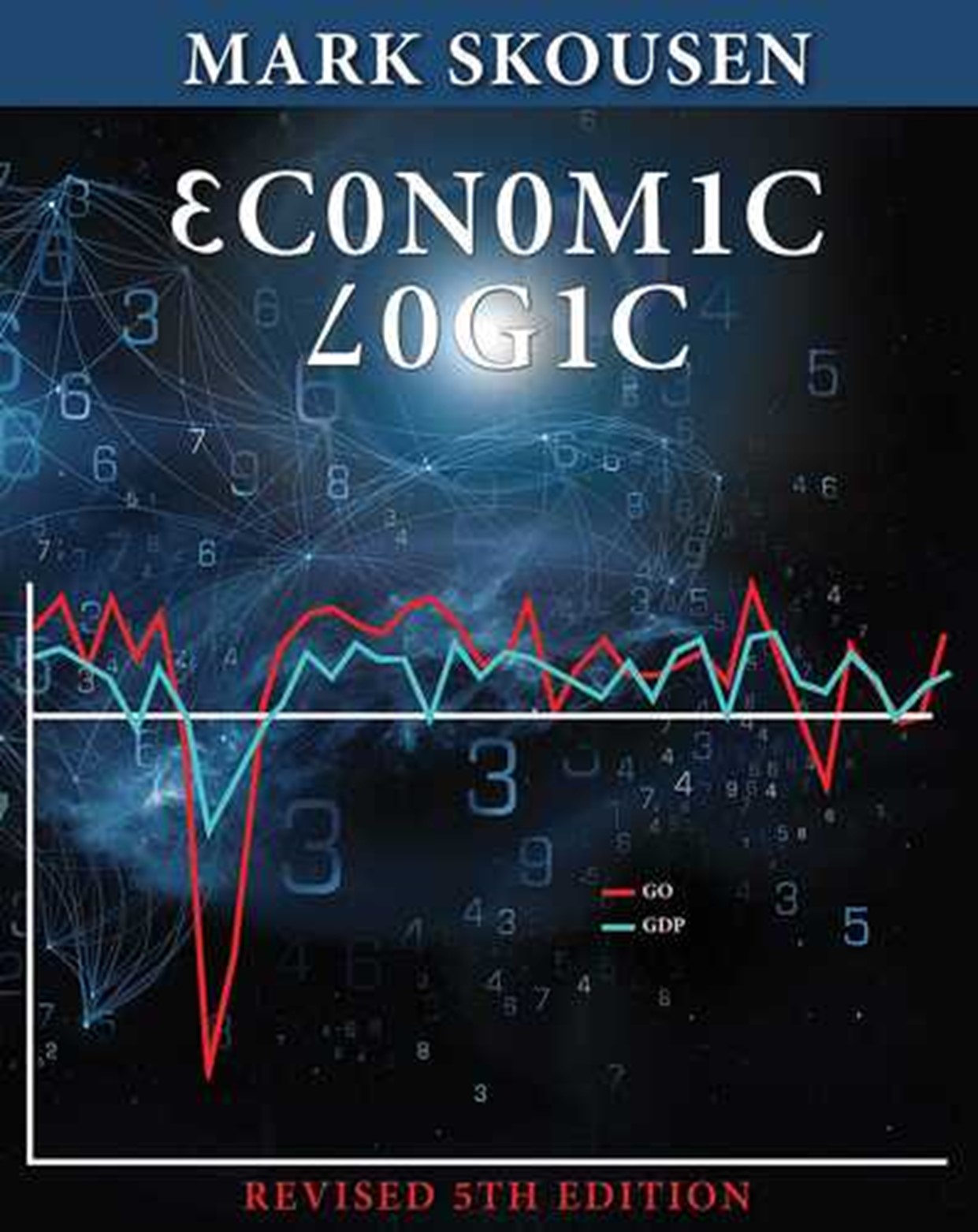Two New Threats to the Booming Economy and the Bull Market… and a Third One is On Its Way
“Taxes are the price we pay for failing to build a civilized society. The higher the tax rates, the greater the failure.” — “Persuasion vs. Force”
“Inflation: When nobody has enough money because everybody has too much.” — Harold Coffin (“Maxims of Wall Street,” p. 152)
First, I have some good news. Today’s gross domestic product (GDP) and gross output (GO) release for the second quarter of 2021 have confirmed that the U.S. economy is booming, justifying a bull market on Wall Street.
The third revised real GDP for the second quarter came out at an annualized rate of 6.7%. GDP has been rising sharply since the lockdown ended in the fall of 2020.
More good news is that adjusted real GO — the top line in national income accounting that included the supply chain — grew at a rate of 7.4%. Whenever total spending in the economy (GO) is rising faster than the final spending of finished goods and services (GDP), it suggests that economic growth is accelerating.
In terms of total spending in the economy (adjusted GO), this figure reached $50 trillion for the first time! GDP, the bottom line, is at $22.7 trillion.
I’ll have a full press release on GO later today at www.grossoutput.com.
Now the Bad News…
I see three potential threats that could derail the economic recovery and the bull market: Higher inflation, higher taxes and higher interest rates (Fed monetary tightening).
Inflation has reared its ugly head. The Consumer Price Index (CPI) is now over 5% for the year. The GDP and GO deflators are at double-digit levels.
It’s official. The parts of the government — Biden, Congress and the Fed — all want more inflation. Even the Federal Reserve is determined to increase the cost of living by 3%.
Consequently, we’re getting inflation and getting it good and hard.
For the past 10 years, government officials fretted about deflation. Not anymore.
The Biden administration has enacted a deliberate policy of raising prices and the cost of living in an all-out effort to raise the minimum wage and stimulate the economy.
We’re living in an inflationary boom, with an emphasis on inflation.
Dollar Store is No Longer

A Retail Store Now Out of Date.
Remember the Dollar Store, where everything was sold for a buck? There are nearly 8,000 of them across the country. Over the past couple of years, the company’s profit margins have been squeezed due to rising supply chain and freight costs that have eaten into earnings.
Yesterday, management announced that the prices on all items will be raised to anywhere between $1.25 and $1.50. The discounter is also experimenting selling items for $3 and $5.
Inflation is everywhere, including at the gas pump, at the fast-food restaurants, at the grocery store and in the entertainment industry.
Long-Term Care Policies to Rise 20%
I just received a notice from Dave Phillips, my estate planning specialist, who told me that his top insurance company was raising its premium on long-term care policies by 20%. (If you still want to buy this policy, you can do so before the 20% increase — contact Dave Phillips, or his son, Todd, at Estate Planning Specialists. The telephone number is 888-892-1102. Alternatively, you can go to their website, https://epmez.com/.
The Bureau of Labor Statistics says that inflation, as measured by the Consumer Price Index, is running at a 5.4% rate this year. I suspect the cost-of-living index is much higher and is probably at 10% or more.
According to Shadow Stats, the real CPI is rising at double-digit-percentage rates:

Source: http://www.shadowstats.com/alternate_data/inflation-charts
Threat #1: Why Inflation Is Worse Than Taxation
Why is inflation more dangerous than taxation? Because taxation is limited, but inflation is unlimited, and it can increase by more than 100%.
As Ludwig von Mises once declared, “Government is the only agency that can take a valuable commodity like paper, slap some ink on it and make it totally worthless.” (“Maxims,” p. 152).
Threat #2: Higher Taxes on Entrepreneurs and Investors
The second major threat is higher taxes. Biden and the Democrats are determined to punish the rich and successful in America by raising the corporate tax rate to 26.5%, making the income tax system more progressive and complex, and eliminating the exemption on long-term capital gains, all in a vain attempt to reduce the ballooning federal deficit.
I doubt they will get all they want, but a watered-down version is possible.
Threat #3: The Fed Raises Interest Rates
The third threat has the most potential of creating a bear market on Wall Street — the Fed tightening and raising interest rates to “fight inflation” and creating a negative yield curve.
Whenever short-term rates are higher than long-term rates, it usually means a recession and a bear market are on the way.
We are far from that right now. We currently have a positive yield curve. The interest rate on three-month Treasury bills is still at near zero (0.4%), 10-year Treasuries are at 1.55% and 30-year Treasury bonds are yielding 2%.
Your Goal is to Beat the Triple Threats
You need to increase your net worth by more than 10% after taxes in order to stay financially independent. To do so, you have two choices: Either invest in your own profitable business or invest in successful companies on the stock market. It’s a tall order, but it can be done.
For example, the SPDR S&P 500 ETF Trust (NYSEARCA: SPY), which I recommend in Forecasts & Strategies, is up 20% this year.
A Harvard-Trained Lawyer Discovers Economic Logic!
At last month’s MoneyShow in Las Vegas, I met a most interesting investment banker and lawyer. His name is Kaj Ahlburg, and he lives in Port Angeles, Washington. He is the past president of the Port Angeles Business Association, as well as the one who sued the Obama administration over the mandates in Obamacare.
Forty years ago, he said, he graduated with a degree in economics in Ontario, Canada, and then got a law degree from Harvard.
Years later, he discovered my guidebook “Economic Logic,” which contains 28 valuable lessons on inflation, taxation, the business cycle, investing and the fundamental keys to economic growth and prosperity.
It is the only “no compromise” textbook in free-market economics, with in-depth criticisms of all the various forms of socialism, Keynesianism and Marxism.
Kaj told me, “What a breath of fresh air! How I wish to have had such a textbook 40 years ago, rather than deadening uniformity of Keynesian rubbish found in all the other economics textbooks!”
He continued, “In 40 years as a banker and investor, I saw how useless the economics I was taught in college was, and how little it has to do with how the real world works. ‘Economic Logic’ provides the tools to analyze how the real economy works and how real people react to economic stimuli.
“Now my son is studying economics, suffering with textbooks teaching the same Keynesian rubbish as 40 years ago. I will give him ‘Economic Logic’ to read as an antidote.
“Thank you for all you do!”
Thank you, Kaj. Economic Logic is indeed perfect antidote to the bad economics that students are being taught in today’s classrooms.

You can read all about Economic Logic here.
My book has been endorsed by Steve Forbes, who said, “His textbook, ‘Economic Logic’, now in its 5th edition, demonstrates his ability to look at the whole economy, that is, the real world and real people. The rigidity between micro and macroeconomics is not for him. He realizes instead that they’re all connected together. He begins this book with a profit-loss income statement to demonstrate the dynamics of the real-world economy. No other textbook does this.
“Skousen’s book brings in many other disciplines to teach lessons of economics, whether it is history, sociology, finance or marketing management. He recognizes that individual departments may be a convenient way for universities to organize their academic activities, but in the real world, it does not advance learning. They need to be integrated. In that sense, he is the spiritual heir of Adam Smith, harking back to a time before mathematicians took over economics.”
Economic Logic is a 708-page quality paperback with 28 lessons or chapters, and it is ideal for college, advanced high school and home-schooled students.
For a special rate of ONLY $35 (28% off the $48.95 full price) with FREE SHIPPING in the United States go to www.skousenbooks.com.
P.S. Come join me and over 60+ top trading and investing educators as we share our favorite strategies that are working for us right now. The Wealth365 Summit is the biggest and most prestigious trading and investing summit in the world and this is the hottest ticket this fall. You won’t want to miss it. Plus, it’s 100% free to attend and the $250,000 in prizes is pretty awesome too. CLICK HERE to register for the October Wealth365 Summit now! I’ll see you there!
Good investing, AEIOU,
![]()
Mark Skousen
Too Many Commercials
“Too many commercials probably isn’t the main reason people cancel their cable-TV service. But it’s definitely in the top five.” — Former Turner TV executive
Like a lot of Americans, this past summer, I watched a lot of cable television as a form of relaxation during the pandemic.
I was surprised by the increased number of commercials running on cable TV. Sometimes the ads run for five minutes before the show starts again.
The television industry has admitted to increasing the number of commercials per hour.
And many of the commercials are either boring, repetitive or a turn-off, such as the drug ads that contain lots of warnings about side effects. At the end of the ad, I think, “Who in the world would want to take that drug?”
I remember when cable became available years ago, the idea was that customers pay a high monthly fee for television with minimum commercial content, since TV was no longer free.
It turns out that we are paying even higher monthly fees and getting even more commercials.
There are still a few channels that are ad-free, such as Turner Classic Movies, public television (except the lengthy requests for donations) and C-SPAN.
Even the History and Discovery channels, which used to be ad free, are now commercialized in every way.
Many customers are now recording their favorite shows, sporting events or movies and then fast forwarding through the commercials.
In addition, more and more customers are switching to live streaming competitors such as Netflix or Hulu.
Creative customers are always coming up with ways around commercial TV.

